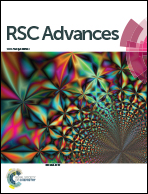Organocatalytic stereoselective approach to the total synthesis of (−)-halosaline†
Abstract
A practical and efficient organocatalytic approach to the synthesis of substituted piperidine alkaloids in high enantio- and diastereomeric excess was achieved using proline-catalyzed sequential α-aminoxylation/α-amination reaction and HWE olefination reaction of an aldehyde.


 Please wait while we load your content...
Please wait while we load your content...